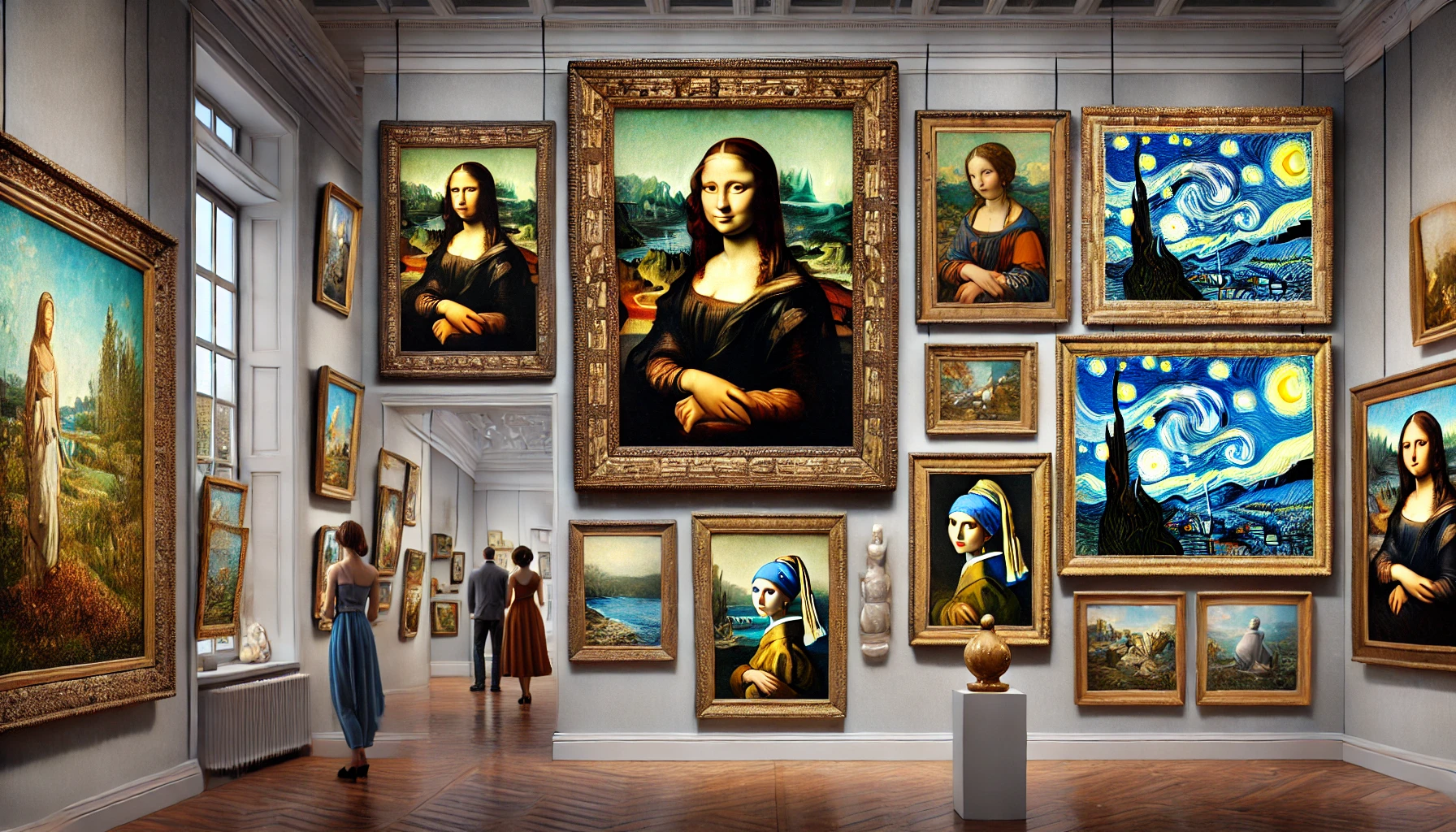Oil painting is an illustrious art form that has stood the test of time, captivating audiences with its depth, vibrancy, and versatility. Throughout history, numerous masterpieces have emerged, each painting telling its own unique story and reflecting the era in which it was created. In this article, we will embark on a journey through some of the most famous oil paintings, exploring their significance, the artists behind them, and the techniques that make them enduring pieces of art.
The Dawn of Oil Painting
Oil painting began to gain prominence during the early Renaissance in the 15th century. This period marked a significant shift from the tempera paint traditionally used on wood panels to oil paint, which allowed for richer color and more detailed, realistic depictions. The flexibility of oil paint also enabled artists to work on larger canvases and create more complex compositions.
The Arnolfini Portrait by Jan van Eyck (1434)
One of the earliest and most iconic oil paintings is Jan van Eyck’s The Arnolfini Portrait. This painting is celebrated for its meticulous detail and complex symbolism. It depicts a wealthy merchant, Giovanni di Nicolao di Arnolfini, and his wife, surrounded by various objects that each hold a specific meaning. Van Eyck’s use of oil paint allowed for the fine detail in the textures of fabrics, the gleam of the chandelier, and the reflections in the convex mirror.
The Birth of Venus by Sandro Botticelli (1486)
Sandro Botticelli’s The Birth of Venus is another masterpiece from the Renaissance era. While not strictly an oil painting, it combines tempera and oil on canvas, illustrating the transition between mediums. This painting captures the mythological birth of Venus, the Roman goddess of love and beauty, emerging from the sea. Botticelli’s use of flowing lines and delicate color palette creates a sense of ethereal beauty and grace.
The Golden Age: Baroque and Beyond
The Baroque period brought a dramatic flair to oil painting, with artists emphasizing movement, emotion, and vivid contrast between light and dark. This era produced some of the most dynamic and emotionally powerful works in art history.
The Night Watch by Rembrandt van Rijn (1642)
Rembrandt’s The Night Watch is a quintessential Baroque painting known for its dramatic use of light and shadow, known as chiaroscuro. This monumental canvas depicts a militia company, capturing the energy and motion of its members. Rembrandt’s mastery of oil paint is evident in the rich textures and lifelike detail of each figure, making the scene almost leap off the canvas.
Las Meninas by Diego Velázquez (1656)
Diego Velázquez’s Las Meninas is a complex and enigmatic painting that has fascinated viewers for centuries. The composition features a group portrait of the Spanish royal family, with Velázquez himself painting at an easel. The clever use of perspective and the mirror reflecting the king and queen add layers of depth and intrigue. Velázquez’s skillful application of oil paint brings a remarkable realism to the figures and their surroundings.
The Enlightenment and Romanticism
The 18th and 19th centuries saw the rise of the Enlightenment and Romanticism, movements that expanded the thematic scope of oil painting to include nature, emotion, and the sublime.
The Raft of the Medusa by Théodore Géricault (1818-1819)
Théodore Géricault’s The Raft of the Medusa is a powerful Romantic painting that depicts the aftermath of a contemporary shipwreck. The emotional intensity and dramatic composition of this work highlight the suffering and despair of the survivors. Géricault’s meticulous research and use of oil paint to convey the raw human condition make this painting a poignant commentary on human endurance and tragedy.
The Fighting Temeraire by J.M.W. Turner (1839)
J.M.W. Turner’s The Fighting Temeraire captures the Romantic fascination with nature and the passage of time. This painting depicts the once-mighty warship, HMS Temeraire, being towed to its final berth. Turner’s mastery of light and color in oil paint creates a luminous, almost ethereal atmosphere, evoking a sense of nostalgia and melancholy.
Modern Masterpieces
The advent of modern art in the late 19th and early 20th centuries brought about radical changes in style and technique. Artists began to experiment with abstraction, color theory, and new perspectives.
Starry Night by Vincent van Gogh (1889)
Vincent van Gogh’s Starry Night is one of the most recognizable oil paintings in the world. Painted during his time at the Saint-Paul-de-Mausole asylum, this work is characterized by its swirling, dream-like sky and vibrant use of color. Van Gogh’s expressive brushstrokes and thick application of oil paint convey intense emotion and energy, making it a quintessential piece of Post-Impressionist art.
The Persistence of Memory by Salvador Dalí (1931)
Salvador Dalí’s The Persistence of Memory is an iconic example of Surrealism. The painting features melting clocks draped over a desolate landscape, challenging conventional notions of time and reality. Dalí’s precise, almost hyper-realistic technique with oil paint creates a surreal and haunting atmosphere that continues to captivate audiences.
Famous oil paintings throughout history have not only captivated art enthusiasts but also influenced the cultural landscape across centuries. From the meticulous details of Renaissance masterpieces like The Arnolfini Portrait by Jan van Eyck to the dramatic compositions of Baroque works such as The Night Watch by Rembrandt, these paintings showcase the evolution of artistic techniques and themes. Exploring these artworks provides valuable insights into the historical context and aesthetic principles that have shaped the world of art. By delving into the stories behind these paintings, we gain a deeper appreciation for the artists’ ingenuity and the lasting impact of their creations on art history.
Informative List of Famous Oil Paintings
- The Arnolfini Portrait by Jan van Eyck (1434)
- Known for its intricate detail and symbolic elements.
- The Birth of Venus by Sandro Botticelli (1486)
- Celebrates the mythological birth of Venus with a delicate and graceful composition.
- The Night Watch by Rembrandt van Rijn (1642)
- Features dramatic use of light and shadow in a dynamic group portrait.
- Las Meninas by Diego Velázquez (1656)
- A complex portrayal of the Spanish royal family with ingenious use of perspective.
- The Raft of the Medusa by Théodore Géricault (1818-1819)
- A harrowing depiction of human suffering and endurance.
- The Fighting Temeraire by J.M.W. Turner (1839)
- Captures the melancholic beauty of a historic warship’s final journey.
- Starry Night by Vincent van Gogh (1889)
- An emotionally charged, vibrant depiction of a night sky.
- The Persistence of Memory by Salvador Dalí (1931)
- A surreal exploration of time and reality through melting clocks.
Conclusion
Oil painting has a rich and diverse history, with each era contributing its own unique masterpieces. From the detailed realism of the Renaissance to the emotional intensity of Romanticism and the bold experimentation of modern art, these paintings continue to inspire and captivate audiences worldwide. By understanding the stories and techniques behind these famous oil paintings, we gain a deeper appreciation for the artistic genius and cultural significance they embody. Whether you are an art aficionado or a casual admirer, exploring these works offers a fascinating glimpse into the evolution of artistic expression throughout history.

